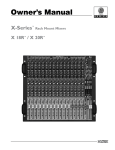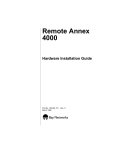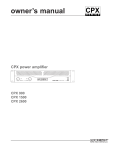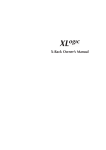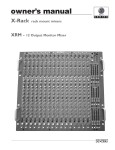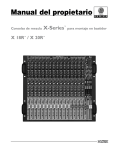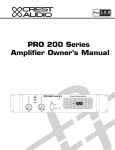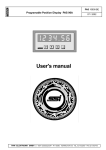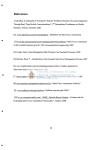Download Crest Audio X 20R Owner`s manual
Transcript
owner’s manual X-Rack XR-20 XR-24 rack mount mixers Important precautions 1 Save the carton and packing materials! Should you ever need to ship the unit, use only the original factory packing. For replacement packaging, call Crest Audio’s Customer Service Department directly. 2 3 Read all documentation before operating your equipment. Retain all documentation for future reference. Follow all instructions printed on unit chassis for proper operation. Service Information Do not open unit! Opening the unit will expose you to potentially dangerous voltages. There are no user serviceable parts inside. Equipment should be serviced by qualified service personnel when: A. The equipment has been exposed to rain. B. The equipment does not appear to oper- ate normally, or exhibits a marked change in performance. C. The equipment has been dropped, or the enclosure damaged. 4 Do not use the unit if the electrical power cord is frayed or broken. The power supply cord should be routed so that it is not likely to be walked on or pinched by items placed upon or against it. 5 Always operate the unit with the AC ground wire connected to the electrical system ground. Precautions should be taken so that the means of grounding of a piece of equipment is not defeated. 6 Damage caused by connection to improper AC voltage is not covered by any warranty. 7 Do not spill water or other liquids into or on the unit, or operate the unit while standing in liquid. 8 The power cord of equipment should be unplugged from the outlet when left unused for a long period of time. To obtain service: contact your nearest Crest Audio Service Center, Distributor, Dealer, or Crest Audio at 201.909.8700 USA or visit www.crestaudio.com for additional information. email techserve @crestaudio.com XR-20 / XR-24 owner’s manual This symbol is used to alert the operator to follow important procedures and precautions detailed in documentation. This symbol is used to warn operators that uninsulated “dangerous voltages” are present within the equipment enclosure that may pose a risk of electrical shock. IMPORTANT SAFETY INSTRUCTIONS WARNING: When using electrical products, basic cautions should always be followed, including the following: 1. 2. 3. 4. 5. 6. 7. 8. 9. 10. 11. 12. 13. 14. 15. 16. 17. Read these instructions. Keep these instructions. Heed all warnings. Follow all instructions. Do not use this apparatus near water. Clean only with a dry cloth. Do not block any of the ventilation openings. Install in accordance with manufacturer’s instructions. Do not install near any heat sources such as radiators, heat registers, stoves or other apparatus (including amplifiers) that produce heat. Do not defeat the safety purpose of the polarized or grounding-type plug. A polarized plug has two blades with one wider than the other. A grounding type plug has two blades and a third grounding plug. The wide blade or third prong is provided for your safety. If the provided plug does not fit into your outlet, consult an electrician for replacement of the obsolete outlet. Protect the power cord from being walked on or pinched, particularly at plugs, convenience receptacles, and the point they exit from the apparatus. Only use attachments/accessories provided by the manufacturer. Use only with a cart, stand, tripod, bracket, or table specified by the manufacturer or sold with the apparatus. When a cart is used, use caution when moving the cart/apparatus combination to avoid injury from tip-over. Unplug this apparatus during lightning storms or when unused for long periods of time. Refer all servicing to qualified service personnel. Servicing is required when the apparatus has been damaged in any way, such as power-supply cord or plug is damaged, liquid has been spilled or objects have fallen into the apparatus, the apparatus has been exposed to rain or moisture, does not operate normally, or has been dropped. Never break off the ground pin. Write for our free booklet “Shock Hazard and Grounding.” Connect only to a power supply of the type marked on the unit adjacent to the power supply cord. If this product is to be mounted in an equipment rack, rear support should be provided. Exposure to extremely high noise levels may cause a permanent hearing loss. Individuals vary considerably in susceptibility to noise-induced hearing loss, but nearly everyone will lose some hearing if exposed to sufficiently intense noise for a sufficient time. The U.S. Government’s Occupational and Health Administration (OSHA) has specified the following permissible noise level exposures: Duration Per Day In Hours 8 6 4 3 2 1 1/2 1 1/2 1/4 or less Sound Level dBA, Slow Response 90 92 95 97 100 102 105 110 115 According to OSHA, any exposure in excess of the above permissible limits could result in some hearing loss. Ear plugs or protectors to the ear canals or over the ears must be worn when operating this amplification system in order to prevent a permanent hearing loss, if exposure is in excess of the limits as set forth above. To ensure against potentially dangerous exposure to high sound pressure levels, it is recommended that all persons exposed to equipment capable of producing high sound pressure levels such as this amplification system be protected by hearing protectors while this unit is in operation. SAVE THESE INSTRUCTIONS! table of contents Introduction Thank you and congratulations on your purchase of your new Crest Audio X-Rack mixer. We’re confident that you will enjoy many years of trouble-free service from it. You will quickly find that it fits into a wide variety of mixing applications with ease. Due to well thought out sets of features, coupled with intelligent circuit design and the highest standards in construction & workmanship, all Crest Audio console products excel above and beyond the competitor’s products, in every area. This owner’s manual covers both the XR-20 and the XR-24 XRack mixers. Features are identical for both models, the only difference is the amount of Mono Inputs versus Stereo Inputs. The XR-20 has 12 Mono inputs and 4 Stereo inputs, adding up to a total of 20 microphone inputs. The XR-24 has 8 Mono inputs and 8 Stereo inputs, adding up to a total of 24 microphone Inputs. Please read this manual thoroughly and keep it handy for future reference. If you have any operating concerns that are not covered in this manual, or have application questions of any type, don’t hesitate to contact Crest Audio directly either by phone, fax, or email. Here is our technical support contact information: Phone: (201) 909 8700 Fax: (201) 909 8744 Email: [email protected] Mono Input channels p. 7 Front panel controls and rear panel connections Stereo Input channels p.17 Front panel controls and rear panel connections Master section P .27 Aux masters, groups, main outs, monitor section. Front panel controls and rear panel connectors. Specifications P. 47 1 2 3 4 XR-20/24 block diagram JIMI XR-20 / XR-24 owner’s manual p. 4 how to use this manual format This manual uses a format that is intended to be easy to read, yet technical for those who need to know all the details. For feature descriptions, this is done by devoting the left side of each page to 1) an overall module picture, 2) a block diagram, and 3) a control closeup. These images all pertain to the features and control descriptions on the right side of the page. The intention is to make the manual easy to read while including all the technical details needed for getting the most out of the X-Rack - a compact, flexible, feature-rich addition to Crest Audio's growing line of audio mixing console products. conventions Control Icons This manual uses symbols to illustrate what the control descriptions are referring to. This makes it possible to avoid redundant wording and makes the control descriptions clear. Switch in the UP, non-activated position Switch in DOWN, activated position Switch that illuminates when in the DOWN position Momentary switch that illuminates when activated LEDthat is on, indicating that it's associated feature is activated Potentiometer Standard 1/4" TRS jack (used for line level inputs and insert sends) 1/4" TRS jack with normal switching (used on insert returns) Female XLRinput jack Male XLR output jack p. 5 1 Mono input channel XR-20 / XR-24 owner’s manual Module Controls Block diagram +48V ON +48V BAL MIC IN LINE GAIN 12 - 70 dB HPF 70Hz -18dB/Oct HPF BAL LINE IN 27dB PAD p. 6 INPUT PREAMP Mono Input channel 1 Front panel features Mono Input channel features are identical for both the XR-20 and the XR-24. The XR-20 has 12 Mono inputs and the XR-24 has 8 Mono inputs. Line Input (mic pad) The input preamp circuit is set up to accept a mic-level signal. This signal is brought in via the XLR mic-input connector located on the rear panel. The 1/4" TRS input jack is disabled. The input preamp circuit is set up to accept a line-level signal from either the XLR mic-input connector or the 1/4" TRS input jack, both located on the rear panel. Since the sensitivity of the input preamp is reduced, this control can also act as a PAD for bringing a very hot microphone feed down to a controllable level, avoiding overload. When a plug is inserted into the 1/4" TRS input jack, the XLR mic-input connector is disabled. Gain The Input gain control is used to establish proper gain structure in the channel. For best results, use the Solo system to monitor the channel while you set the gain. The goal is maximum gain without distortion. Both the main LED meters (during Solo) and the channel’s Level/Peak indicator can be used for adjusting gain. 70 Hz high-pass filter The high-pass filter reduces or eliminates unwanted low frequencies without substantially affecting the program material. Quite often such unwanted low frequencies are included with mic- or line-input signals. For example, stage rumble or wind can be picked up through vocal mics. The cut-off frequency of the high-pass filter is 70 Hz and the slope is -18dB per octave. HPF High-pass filter is on. p. 7 1 Mono input channel XR-20 / XR-24 owner’s manual Module Controls Block diagram LEVEL FREQ LEVEL FREQ LEVEL LEVEL HI MID 400 - 8 KHZ HF 12 KHZ EQ ON LF 80 HZ LOW MID 80 - 2 KHZ FOUR BAND EQ p. 8 Mono Input channel 1 Front panel features EQ Many audio signals coming into the console require some degree of corrective eq in order to be part of a good sounding mix. XR-20 & XR-24 offer a very useful and great sounding eq section on each channel. The input EQ consists of four bands: High, High-mid, Low-mid and Low. The High and Low frequency bands each have a boost/cut control and their frequencies are fixed. The High-mid and Lowmid bands each have variable boost/cut and variable frequency. high frequency—HF Boost / Cut 15dB boost and cut. Shelving @ 12 kHz high mid—HM Frequency Continuously sweepable between 400 Hz and 8 kHz. Boost / Cut 15dB boost and cut. Bell curve with a Q of 1 Low mid—LM Frequency Continuously sweepable between 100 Hz and 2 kHz. Boost / Cut 15dB boost and cut. Bell curve with a Q of 1 Low frequency—LF Boost / Cut 15dB boost and cut. Shelving @ 80 Hz. EQ on Equalizer is on. This switch is used to activate the EQ section and can be used to make A/B comparisons between "flat" and eq'd signals. p. 9 1 Mono input channel XR-20 / XR-24 owner’s manual Module Controls Block diagram MUTE EQ ON HF 12 KHZ PAN CHAN FADER MONO L-R G1-2 G3-4 FADER AMP BUS ASSIGN SWITCHES +10 100MM YES PRE SOURCE MUTE ? A1-2 PRE PAN 1-2 LEVEL 1-2 A1 A2 PRE EQ NO PRE FADER A3-4 PRE PRE-SOURCE BUFFER PRE INSERT PRE-SOURCE SELECT LEV 3 LEV 4 A5-6 PRE LEV 5 LEV 6 AUX SENDS 1 THRU 6 p. 10 A3 A4 A5 A6 Mono Input channel 1 AUX send features Six auxiliary sends are available for creating individual output mixes. These can be used to drive effects processors, provide monitor mixes, create broadcast or alternate sound reinforcement mixes, or for other special requirements. Note: The default PRE setting for the Auxes is pre-fader, but post-mute, post-insert, and post eq. Internal settings can be changed so that PRE is also preeq and pre mute Aux 1 - 2 PRE AUX 1/2 stereo pair is post fader AUX 1/2 stereo pair is pre-fader Aux sends 1 & 2 Auxes 1 and 2 are configured as a stereo pair. The top knob controls the level and the bottom knob acts as a PAN control. This stereo aux send can be used for any type of stereo feed from the console, such as live two-track recording, stereo in-ear monitors, alternate stereo feed for broadcast, and stereo signal processors. Also, by properly using the pan control Auxes 1 and 2 can be used as discrete mono Aux buses Aux 1/2 level Send level for the Aux 1/2 stereo pair Aux 1/2 PAN Stereo placement for the Aux 1/2 stereo pair AUX 3-4 PRE AUX 3 and AUX 4 are post fader AUX 3 and AUX 4 are pre-fader Aux sends 3, 4, 5 & 6 Auxes 3, 4, 5, & 6 are configured as descrete mono aux sends. They are typically used to feed signal processors and for on-stage monitors. Auxes 3, 4, 5, &6 level Set levels Auxes 3, 4, 5, & 6. AUX 5-6 PRE AUX 5 and AUX 6 are post fader. AUX 5 and AUX 6 are pre-fader. p. 11 1 Mono input channel XR-20 / XR-24 owner’s manual Module Controls Block diagram PFL SOLO LEFT SOLO RIGHT TO PEAK CIRCUIT SOLO DC MUTE EQ ON PAN CHAN FADER MONO L-R G1-2 G3-4 FADER AMP BUS ASSIGN SWITCHES +10 100MM YES PRE SOURCE MUTE ? A1-2 PRE PAN 1-2 LEVEL 1-2 A1 A2 PRE EQ NO PRE FADER A3-4 PRE PRE-SOURCE BUFFER PRE-SOURCE SELECT LEV 3 LEV 4 A5-6 PRE LEV 5 LEV 6 AUX SENDS 1 THRU 6 p. 12 A3 A4 A5 A6 Mono Input channel 1 Bus assignment features The bus assignment section offers considerable flexibility for creating what eventually becomes the main output mix. Two stereo subgroups are available for creating submixes or separate stereo mixes. All assignments are derived post-fader, post-eq, and post-mute. PAN control The pan control positions the signal within the stereo left/right (or odd/even) field. PAN affects signals that are assigned directly to Left-Right, Groups 1-2 and Groups 3-4 Mono bus assign The channel is assigned to the MONO mix bus. PAN has no affect on MONO L-R bus assign The channel is assigned to the Left and Right mix buses. G 1-2 bus assign The channel is assigned to Groups 1 and 2. Groups 1 and 2 are configured as a stereo pair. They can also be treated as two discrete mono groups by using the PAN control. G 3-4 bus assign The channel is assigned Groups 3 and 4. Groups 4 and 4 are configured as a stereo pair. They can also be treated as two discrete mono groups by using the PAN control. Input fader (100mm) The fader is the primary level control for signals being sent to any of the consoles post fader mix buses, MUTE The input channel is muted and the MUTE LED is alluminated. All AUX feeds and bus assignments are shut off. Insert send and SOLO signals are still active. PK / SIG LED indicator This two-color(green & red) LED is used to monitor the channel’s signal level. Signal present (green) is monitored pre-fader. Peak (red) is monitored at the preamp and before & after the fader. PFL PFL -Pre fader listen. This button routes the channel’s signal to the Solo bus for monitoring through headphones or in the control room. The Peak (red) LED is illuminated to show PFL status. p. 13 1 Mono input channel XR-20 / XR-24 owner’s manual Connectors Rear panel Block diagram HPF 70Hz -18dB/Oct GAIN 12 - 70 dB BAL MIC IN LINE HPF BAL LINE IN INPUT PREAMP 27dB PAD INSERT SEND / RTN POST FADER DIRECT OUT SOURCE DIRECT OUT GC PRE FADER REAR PANEL X-RACK MONO INPUT MODULE 12 OR 8 MO NO INPUTS AVAILABLE PFL SOLO LEFT +48V ON +48V SOLO RIGHT GAIN 12 - 70 dB BAL MIC IN LINE TO PEAK CIRCU IT HPF 70Hz -18dB/Oct LEVEL FREQ LEVEL FREQ LEVEL LEVEL PAN EQ ON LF 80 HZ HPF LOWMID 80 - 2 KHZ HI MID 400 - 8 KHZ HF 12 KHZ CHAN FAD ER INPUT SIGNAL LED INSERT SEND / RTN POST FAD ER DIRECT OUT GC PRE FADER REAR PANEL G1-2 G3-4 100MM SOLO TRIGGER YES PRE SOURCE MUTE ? PEAK R (PFL) DIRECT OUT SOURCE L-R BUS ASSIG N SW ITCH ES +10 INPUT PREAMP 27dB PAD MONO FADER AMP FOUR BAND EQ BAL LINE IN SOLO DC MUTE A1-2 PRE PAN 1-2 LEVEL 1-2 A1 A2 SIG PRE EQ G NO PRE FADER POST FADER PRE FADER A3-4 PRE PRE-SOURCE BUFFER LEV 3 A3 LEV 4 A4 PRE INSERT PRE-SOURCE SELECT A5-6 PRE LEV 5 A5 LEV 6 A6 AUX SENDS 1 THRU 6 p. 14 Mono Input channel 1 Rear panel features 48 V Phantom power 48 volts DC is applied to pins 2 and 3 on the mic-input XLR connector.This option is used with condenser microphones and active direct boxes that require an external DC voltage (phantom power ) in order to operate. Line INPUT jack Line-level signals, balanced or unbalanced, may be brought into the input channel through this jack. The LINE INPUT switch must be pressed for this jack to be active. MIC INPUT jack This balanced female XLR accepts a low-impedance microphone signal, or a line-level signal, depending on the position of the LINE INPUT switch on the front panel. INSERT jack This switching 1/4” TRS jack allows an external signal processor to be inserted into the signal path of the channel. The tip carries the SEND signal and the ring carries the RETURN signal. DIRECT OUT jack The channel’s signal can be brought out of the console via the direct out jack. The signal that appears at this jack is normally post fader.There is an internal option for making it pre fader. p. 15 1 Stereo input channel XR-20 / XR-24 owner’s manual Controls Module Block diagram +48V ON +48V BAL MIC IN LINE GAIN 15 - 60 dB MONO BAL LEFT BAL LINE IN 27dB PAD PRE EQ BAL MIC IN RIGHT INPUT SIGNAL LED BAL LINE IN 27dB PAD INPUT PREAMP PEAK R (PFL) SIG p. 16 Stereo Input channel 1 Front panel features Stereo Input channels features are identical for both the XR-20 and the XR-24. The XR20 has 4 Stereo inputs, and the XR-24 has and 8 Stereo inputs. On both models the Stereo inputs are located to the left of the master section, to the right of the Mono inputs. They can be treated as mono input channels, or as Stereo input channels. Stereo Line Input (mic pad) The stereo input preamp circuit is set up to accept mic-level signals. The signals are brought in via the XLR mic-input connectors located on the rear panel. The 1/4" TRS input jacks are disabled. The stereo input preamp circuits are set up to accept line-level signals from either the XLR mic-input connectors or the 1/4" TRS input jacks, all located on the rear panel. Since the sensitivity of the stereo input preamp is reduced, this control can also act as a PAD for bringing very hot microphone feeds down to a safe level, avoiding overload. When a plug is inserted into a 1/4" TRS input jack, the XLR connector is disabled. Gain The Input gain control is used to establish proper gain structure in the channel. The GAIN control affects both the Left and Right input signals. For best results, use the Solo system to monitor the channel while you set the gain. The goal is maximum gain without distortion. Both the main LED meters (during Solo) and the channel’s Level/Peak indicator can be used for adjusting gain. SUM INPUTS By summing the inputs, a stereo input channel can be used as a mono input channel. The channel functions as a stereo input. If signals are applied to both the Left and Right input jacks, they will be summed together as a mono signal. If a signal is applied to just one of the input jacks, it will be treated as a mono signal throughout the rest of the channel. p. 17 1 Stereo input channel XR-20 / XR-24 owner’s manual Controls Module Block diagram PRE FADER ONO LEVEL FREQ LEVEL BAL FREQ LEVEL LEVEL HI MID 400 - 8 KHZ HF 12 KHZ MUTE EQ ON LF 80 HZ LOW MID 80 - 2 KHZ CHAN FADER FOUR BAND EQ - LEFT PRE EQ LF 80 HZ LOW MID 80 - 2 KHZ HI MID 400 - 8 KHZ FOUR BAND EQ - RIGHT p. 18 HF 12 KHZ 100MM FA Stereo Input channel 1 Front panel features Stereo EQ The Stereo Input channel has two parallel EQ circuits that are controlled by the same set of knobs. high frequency—HF Boost / Cut 15dB boost and cut. Shelving @ 12 kHz high mid—HM Frequency Continuously sweepable between 400 Hz and 8 kHz. Boost / Cut 15dB boost and cut. Bell curve with a Q of 1 Low mid—LM Frequency Continuously sweepable between 100 Hz and 2 kHz. Boost / Cut 15dB boost and cut. Bell curve with a Q of 1 Low frequency—LF Boost / Cut 15dB boost and cut. Shelving @ 80 Hz. EQ on Equalizer is on. This switch is used to activate the EQ section and can be used to make A/B comparisons between "flat" and eq'd signals. p. 19 2 Stereo input channel XR-20 / XR-24 owner’s manual Controls Module Block diagram PFL SOLO LEFT PRE FADER SOLO RIGHT TO PEAK CIRCUIT MUTE SOLO DC MONO L-R G1-2 G3-4 FADER AMPS CHAN FADER LEFT +10 BUS ASSIGN SWITCHES POST FADER +10 RIGHT 100MM A1-2 PRE PAN 1-2 LEVEL 1-2 LEFT A1 RIGHT A2 YES PRE SOURCE MUTE ? A3-4 PRE LEV 3 L&R MIXED NO LEFT PRE-SOURCE BUFFERS A5-6 PRE LEV 4 A4 LEV 5 L&R MIXED A5 LEV 6 A6 RIGHT AUX SENDS 1 THRU 6 p. 20 A3 Stereo Input channel 2 AUX send features Six auxiliary sends are available for creating individual output mixes. These can be used to drive effects processors, provide monitor mixes, create broadcast or alternate sound reinforcement mixes, or for other special requirements. Note: The default PRE setting for the Auxes is pre-fader, but post-mute, post-insert, and post eq. Internal settings changed be changed so that PRE is also pre-eq and pre mute Aux 1 - 2 PRE AUX 1/2 stereo pair is post fader AUX 1/2 stereo pair is pre-fader Aux sends 1 & 2 Auxes 1 and 2 are configured as a stereo pair. If the channel is configured as a stereo input, the Left and Right signals are routed to Auxes 1 and 2, retaining the stereo split. The PAN knob acts as a balance control. This stereo aux send can be used for any type of stereo feed from the console, such as live two-track recording, stereo in-ear monitors, alternate stereo feed for broadcast, and stereo signal processors. Also, by using the pan control to select a single bus, Auxes 1 and 2 can be used as discrete mono Aux buses Aux 1/2 level Sets level for the Aux 1/2 stereo pair Aux 1/2 PAN If the MONO SUM button is up, this knob controls the stereo balance for Auxes 1 and 2. If the MONO SUM button is down, the summed signal is panned between Auxes 1 and 2 AUX 3-4 PRE AUX 3 and AUX 4 are post fader AUX 3 and AUX 4 are pre-fader Aux sends 3, 4, 5 & 6 Auxes 3, 4, 5, & 6 are configured as descrete mono aux sends. They are typically used to feed signal processors and for on-stage monitors. Stereo signals are summed together to make up the source for Auxes 3, 4, 5 & 6. Auxes 3, 4, 5, & 6 level Set levels Auxes 3, 4, 5, & 6. AUX 5-6 PRE AUX 5 and AUX 6 are post fader. AUX 5 and AUX 6 are pre-fader. p. 21 2 Stereo input channel XR-20 / XR-24 owner’s manual Controls Module PFL SOLO LEFT PRE FADER SOLO RIGHT TO PEAK CIRCUIT MUTE SOLO DC MONO L-R G1-2 G3-4 FADER AMPS CHAN FADER LEFT +10 BUS ASSIGN SWITCHES POST FADER +10 RIGHT 100MM A1-2 PRE PAN 1-2 LEVEL 1-2 LEFT A1 RIGHT A2 YES PRE SOURCE MUTE ? A3-4 PRE LEV 3 L&R MIXED NO LEFT PRE-SOURCE BUFFERS A5-6 PRE LEV 4 A4 LEV 5 L&R MIXED A5 LEV 6 A6 RIGHT AUX SENDS 1 THRU 6 p. 22 A3 Stereo Input channel 2 Bus assignment features The bus assignment section offers considerable flexibility for creating what eventually becomes the main output mix. Two stereo subgroups are available for creating submixes or separate stereo mixes. When the channel is being used as a stereo input, Left/Right, Groups 1 & 2 Groups 3/4 bus assignments are configured as true stereo pairs. Bus assignments are derived post-fader, post-eq, and postmute. BAL control The balance control adjusts the stereo balance for the Group and Left/Right assignments. Mono bus assign The channel is assigned to the MONO mix bus. The Left and Right signals a are summed to make up the MONO signal. BAL has no affect on MONO L-R bus assign The channel is assigned to the Left and Right mix buses. G 1-2 bus assign The channel is assigned Sub Groups 1 and 2. Groups 1 and 2 are configured as a stereo pair. They can also be treated as two discrete mono groups by using the BAL control as an GROUP 1/2 mix control. G 3-4 bus assign The channel is assigned Sub Groups 3 and 4. Groups 4 and 4 are configured as a stereo pair. They can also be treated as two discrete mono groups by using the BAL control as an GROUP 3/4 mix control. Input fader The fader is the primary level control for signals being sent to any of the consoles mix buses, The signals affected are the AUX sends selected to be post-fader and the Mono, L/R, and Groups 1-4. MUTE The input channel is muted and the MUTE LED is alluminated. All AUX feeds and bus assignments are shut off. SOLO is still active. PK / SIG LED indicator This two-color(green & red) LED is used to monitor both the channel’s Left and Right signal levels. Signal present (green) is monitored pre-fader. Peak (red ) is monitored at the preamp and both before & after the fader. PFL PFL -Pre fader listen. This button routes the channel’s signal to the PFL bus for monitoring through headphones or in the control room. The Peak (red) LED is illuminated to show PFL status.Since the SOLO bus is stereo, stereo image is preserved. p. 23 2 Stereo input channel XR-20 / XR-24 owner’s manual Connectors Rear panel Block diagram BAL MIC IN LINE GAIN 15 - 60 dB MONO LEVEL FREQ LEVEL BAL LF 80 HZ LEFT LOW MID 80 - 2 KHZ FOUR BAND BAL LINE IN 27dB PAD PRE EQ LF 80 HZ LOW MID 80 - 2 KHZ BAL MIC IN FOUR BAND RIGHT SOLO TRIGGER INPUT SIGNAL LED BAL LINE IN INPUT PREAMP 27dB PAD PRE-AMP OUT L&R PEAK R (PFL) SIG G REAR PANEL POST FADER X-RACK STEREO INPUT MODULE 4 OR 8 STEREO INPUTS AVAILABLE +48V ON PFL SOLO LEFT +48V PRE FADER BAL MIC IN LINE GAIN 15 - 60 dB MONO LEVEL FREQ LEVEL BAL FREQ LEVEL LEVEL SOLO RIGHT TO PEAK CIRCUIT MUTE SOLO DC EQ ON LF 80 HZ LEFT LOW MID 80 - 2 KHZ HI MID 400 - 8 KHZ MONO HF 12 KHZ L-R G1-2 G3-4 FADER AMPS CHAN FADER LEFT FOUR BAND EQ - LEFT BAL LINE IN +10 27dB PAD BUS ASSIGN SWITCHES POST FADER PRE EQ +10 LF 80 HZ BAL MIC IN LOW MID 80 - 2 KHZ HI MID 400 - 8 KHZ HF 12 KHZ RIGHT 100MM A1-2 PRE FOUR BAND EQ - RIGHT PAN 1-2 LEVEL 1-2 LEFT YES RIGHT SOLO TRIGGER INPUT SIGNAL LED BAL LINE IN 27dB PAD INPUT PREAMP PRE SOURCE MUTE ? PRE-AMP OUT L&R PEAK R (PFL) PRE FADER POST FADER L&R PRE FADER L&R p. 24 PRE FADER RIGHT PRE-SOURCE BUFFERS PRE EQ LEV 3 L&R MIXED LEFT PRE EQ G A3-4 PRE NO LEFT SIG REAR PANEL A1 A2 RIGHT A5-6 PRE LEV 4 LEV 5 L&R MIXED A4 A5 LEV 6 A6 RIGHT PRE-SOURCE SELECT A3 AUX SENDS 1 THRU 6 Stereo Input channel 2 Rear panel features 48 V Phantom power 48 volts DC is applied to pins 2 and 3 on the mic-input XLR connectors. This option is used with condenser microphones and active direct boxes that require an external DC voltage (phantom power ) in order to operate. Line INPUT jacks - Left and Right Line-level signals, balanced or unbalanced, may be brought into the input channel through this jack. The LINE INPUT switch must be pressed for these jack to be active. MIC INPUT jack - Left and Right These balanced female XLRs accept low-impedance microphone signals, or line-level signals, depending on the position of the LINE INPUT switch on the front panel. p. 25 3 Master section XR-20 / XR-24 owner’s manual Module Controls Block diagram +9 6 3 0 -3 6 9 12 15 18 21 24 LED METERS FOLLOW SOLO, NORMALLY SHOW L / R OUT LEFT OUT RIGHT OUT SOLO FEED L-R ADD MONO SOLO CTRL RIGHT PRE-FADER SOLO ON L-R MONO GC L R GC AUX1-2 TAPE IN MONITOR LEVEL SOLO OFF SUM MONO TO PHO NES MO N-L MO N-R GC L MONITOR SOURCE SELECT ( SELECTED SOURCES ADD TOGETHER ) MONITOR OUT R GC SOLO FEED L-R SOLO CTRL TAPE-IN LEVEL TAPE TO AUX 1-2 SOLO MIX AMPS SOLO LEFT SOLO FEED L-R AUX-1 BUS LEFT BUS TAPE-IN L SOLO RIGHT AUX-2 BUS R IGH T BUS TAPE IN L SOLO DC TAPE TO L/R TAPE-IN R SOLO CTRL SO LO CO NTRO L LOG IC TO: PHONES & MONITOR ADD MONO (RECESSED) TAPE IN R TAPE IN FROM MONITOR SOLO OFF HEADPHONE LEVEL LEFT OUT TAPE-IN L MON-L L MON-R R RIGHT OUT TAPE-IN R MONO OUT MONO PRE TO ALT-OU T SOLO FEED L-R SOLO CTRL p. 26 ALT OUT PWR ON AUDIO SOURCES FOR MONITOR - ALL PRE-FADER GRP3-4 GRP1-2 ALT LEVEL LEFT PRE-FADER HEADPHONE AMPS TO: PHONES, MONITOR & METERS Master section 3 Front panel features The XR-20 & XR-24 have a comprehensive output section, including meters, master level controls, and a flexable group assignment section. Headphone control section In normal use, the headphone out is used to monitor the Solo system. The Solo system is made up of anything that is PFL’d (pre-fader-listen) or AFL’s (after fader listen). The hirarchy of what appears in the headphones when nothing is soloed, or when the SOLO OFF button is pressed is as follows: MONITOR when FROM MONITOR is engaged. TAPE IN whenTAPE IN is engaged and FROM MONITOR is not engaged. LEFT and RIGHT masters when neither FROM MONITOR nor TAPE IN are engaged. ADD MONO (RECESSED) TAPE IN FROM MONITOR SOLO OFF HEADPHONE LEVEL LEFT OUT TAPE-IN L MON-L L MON-R R RIGHT OUT TAPE-IN R MONO OUT MONO PRE HEADPHONE AMPS TO ALT-OUT SOLO FEED L-R SOLO CTRL Headphone jack This 1/4” TRS jack is intended for stereo headphones. It can also be used as a stereo control-monitor output from the mixer. From this jack you can get a number of signals, including SOLO, Left, Right & Mono, and Monitor / Tape feeds. Headphone level This knob controls the level that appears at the Headphone Jack. SOLO OFF Solo (PFL or AFL) overrides the default headphone signals unless this button is depressed. Whenever something is Soloed, it appears in the headphones. Soloed signals do not appear in the headphones. p. 27 3 Master section XR-20 / XR-24 owner’s manual Controls Module Block diagram +9 6 3 0 -3 6 9 12 15 18 21 24 LED METERS FOLLOW SOLO, NORMALLY SHOW L / R OUT LEFT OUT RIGHT OUT SOLO FEED L-R ADD MONO SOLO CTRL RIGHT PRE-FADER SOLO ON L-R MONO GC L R GC AUX1-2 TAPE IN MONITOR LEVEL SOLO OFF SUM MONO TO PHO NES MO N-L MO N-R GC L MONITOR SOURCE SELECT ( SELECTED SOURCES ADD TOGETHER ) MONITOR OUT R GC SOLO FEED L-R SOLO CTRL TAPE-IN LEVEL TAPE TO AUX 1-2 SOLO MIX AMPS SOLO LEFT SOLO FEED L-R AUX-1 BUS LEFT BUS TAPE-IN L SOLO RIGHT AUX-2 BUS R IGH T BUS TAPE IN L SOLO DC TAPE TO L/R TAPE-IN R SOLO CTRL SO LO CO NTRO L LOG IC TO: PHONES & MONITOR ADD MONO (RECESSED) TAPE IN R TAPE IN FROM MONITOR SOLO OFF HEADPHONE LEVEL LEFT OUT TAPE-IN L MON-L L MON-R R RIGHT OUT TAPE-IN R MONO OUT MONO PRE TO ALT-OU T SOLO FEED L-R SOLO CTRL p. 28 ALT OUT PWR ON AUDIO SOURCES FOR MONITOR - ALL PRE-FADER GRP3-4 GRP1-2 ALT LEVEL LEFT PRE-FADER HEADPHONE AMPS TO: PHONES, MONITOR & METERS Master section 3 Front panel features FROM MONITOR The post-level control MONITOR output becomes the signal in the headphones when nothing is soloed. This overrides TAPE IN if the TAPE IN button is depressed. TAPE IN The TAPE IN signals appear in the headphones when the FROM MONITOR button is not depressed and nothing is Soloed. ADD MONO to Phones and ALT OUT Mono, or Center can be added when the LEFT and RIGHT masters are present at the Phone out, on the front panel and the ALT OUT jacks on the rear panel. The switch is recessed to prevent it’s state from acidentaly being switched. The default signal at the Headphone output and the ALT OUT jacks is the stereo LEFT/RIGHT mix. In addition to the LEFT/RIGHT mix at he the Headphone output and the ALT OUT jacks, the MONO master signal is blended in. 12 V Lamp jack A BNC jack is used for hooking up a goose-neck lamp. The center connection is 12 Volts DC and the outer connection is ground. A medium or high-intensity 12V DC Littlite is can be used. LED meters - Left and Right A pair of LED arrays are provided for monitoring the output levels. They follow the SOLO system, making it easy to adjust input and output levels by PFL’ing and AFL’ing different sources. They normally show the LEFT and RIGHT output levels. When something is Soloed, it replaces LEFT and RIGHT on the meters. SOLO LED This red LED lights up when anything on the mixer is soloed. PWR LED This green LED illuminates to indicate that the mixer is powered up and ready for use. p. 29 3 Master section XR-20 / XR-24 owner’s manual Controls Module Block diagram TAPE-IN LEVEL TAPE TO AUX 1-2 AU LEFT BUS TAPE-IN L AU RIGHT BUS TAPE IN L TAPE TO L/R TAPE-IN R TO: PHONES & MONITOR ADD MONO (RECESSED) TAPE IN R LEFT OUT TAPE-IN L X-RACK AUX BUSES 1-2 (STEREO PAIR) AUX 1 AUX MIX AMPS INSERT SEND / RTN AUX 2 AUX 1-2 MASTER AFL SOLO LEFT +10 AUX 1 OUT AUX 2 OUT GC SOLO RIGHT GC +10 SOLO DC AUX MIX AMP X-RACK AUX BUSES 3 THRU 6 (1 OF 4 SHOWN) INSERT SEND / RTN AUX MASTER AFL SOLO LEFT +10 SOLO RIGHT AUX OUT SOLO DC GC p. 30 Master section 3 Front panel features TAPE IN level On the rear panel there are Left and Right TAPE IN connectors, both 1/4” TRS and RCA. They can be used to bring in a stereo source such as a two-track playback from tape, CD, MD, or a sampler. This knob controls the level to the Aux 1/2 and Left/Right buses. TAPE IN assignment TO A1-2 This assigns the stereo TAPE IN to Auxes 1 and 2, which are configured as a stereo pair. This is useful for stereo program monitoring. TO L-R This assigns the stereo TAPE IN feed to the Left and Right mix buses. This is useful for in-between-set background music and as an extra stereo return. AUX OUT 1-2 level control This is the master stereo output level control for the AUX 1/2 pair. Aux 1-2 AFL This button assigns the AUX 1/2 stereo pair to the solo system. Since it is AFL, the signal is monitored after the AUX insert and master level control. Auxes 1 & 2 show up in stereo in the System - 1 on the left and 2 on the right. AUX OUT 3, 4, 5 & 6 level controls These are the master output level controls for Auxes 3, 4, 5 &6. Aux 3, 4, 5, & 6 AFL These buttons assign Auxes 3, 4, 5 & 6 to the solo system. Since they are AFL, the signals are monitored after the AUX inserts and master level controls. p. 31 3 Master section XR-20 / XR-24 owner’s manual Controls Module Block diagram X-RACK GROUPS (1 OF 4 SHOWN) GROUP MIX AMP INSERT SEND / RTN PRE FADER MONO LEFT RIGHT GROUP-TO-MAIN ASSIGN SWITCHES ODD GROUPS FEED LEFT SOLO, EVENS FEED RIGHT SOLO GROUP FADER POST FADER PEAK R (AFL) AFL SIG SOLO DC p. 32 G GROUP BUS IN +10 GROUP LED SOLO LEFT SOLO RIGHT TO GROUP MIX-AMP GROUP OUT 60MM GC Master section 3 Front panel features GROUP assignment section The XR-20 offers a flexible group assignment arrangement. Each of the four Groups can be assigned to Left, Right and Mono busses, in any combination. M - Mono assignments for Groups 1, 2, 3 & 4 Each of the four groups has a Mono assignment button for routing its post-fader signal to the Mono mix bus. L - Left assignments for Groups 1, 2, 3 & 4 Each of the four groups has a Left assignment button for routing its post-fader signal to the Left mix bus. R - Right assignments for Groups 1, 2, 3 & 4 Each of the four groups has a Right assignment button for routing its post-fader signal to the Right mix bus. Group Master Faders 1, 2, 3 & 4 Each Group has a master fader for adjusting its overall level. These signals show up at the Group OUT jacks on the rear panel and can be assigned to the Left, Right and Mono buses. They also feed the Solo system when the Group AFL buttons are down. GroupPK / SIG LED indicators These two-color(green & red) LEDs are used to monitor each of the group’s signal levels. Signal present (green) is monitored pre-fader. Peak (red ) is monitored at the preamp and both before & after the fader. AFL buttons for Groups 1, 2, 3 & 4 Each of the four groups has an AFL button for monitoring through the SOLO system. The signal assigned to the Solo bus is picked up after the fader. The groups show up in stereo in the Solo system - odd - left, even right. The Peak (red) LEDs are illuminated to show AFL status. p. 33 3 Master section XR-20 / XR-24 owner’s manual Controls Module Block diagram AUDIO SOURCES FOR MONITOR - ALL PRE-FADER GRP3-4 GRP1-2 L-R MONO AUX1-2 TAPE IN MONITOR SOURCE SELECT ( SELECTED SOURCES ADD TOGETHER ) SOLO FEED L-R SOLO CTRL p. 34 MONITOR LEVEL SOLO OFF SUM MONO TO PHONES MON-L MON-R L GC R GC MONITOR OUT Master section 3 Front panel features MONITOR Output section The XR-20 and XR-24 offer an extensive monitoring system which can be used for several alternate mix and remote listening purposes. The main L/R & M mixes, the Groups, Auxes 1&2, the Tape IN, and the Solo system can all be routed to the Monitor outs. Like the Headphone section, the SOLO system is automatically routed to the Monitors. This can be defeated by pressing the SOLO OFF button. MONITOR Level control This knob controls the signal level that appears at the Monitor output on the rear panel. This signal can also be assigned to the headphone system by pressing the FROM MONITOR button located below the Headphone level control. SUM MONO The MONITOR System operates in stereo, and has Left and Right outputs.You can assign several stereo sources to the Monitor bus,including the Aux 1/2 stereo pair, the Left/Right busses, the TAPE IN, and the Groups,in stereo odd/even pairs. The MONITOR system operates in stereo. . Any stereo signals that are assigned to the Monitor system remain stereo. The MONITOR system operates in mono. Any stereo signals that are assigned to the Monitor system are summed together. SOLO OFF Like the Headphone section, the Solo system is automatically routed to the monitors. .Solo takes overrides anything that is assigned to the monitors. The Solo system does not appear in the monitors. Note If you are 1) routing the Monitor outs to the Headphone system by pressing the FROM MONITOR button in the Headphone section, and, 2) you don’t want the Solo system to show up in the headphones, you must press both SOLO OFF buttons -the one in the Headphone section and the one in the Monitor section. p. 35 3 Master section XR-20 / XR-24 owner’s manual Controls Module Block diagram AUDIO SOURCES FOR MONITOR - ALL PRE-FADER GRP3-4 GRP1-2 L-R MONO AUX1-2 TAPE IN MONITOR SOURCE SELECT ( SELECTED SOURCES ADD TOGETHER ) SOLO FEED L-R SOLO CTRL p. 36 MONITOR LEVEL SOLO OFF SUM MONO TO PHONES MON-L MON-R L GC R GC MONITOR OUT Master section 3 Front panel features MONITOR Output section SOURCE SELECT The Source select portion of the Monitor system allows you do assign the primary mix buses to the Monitor outputs. All assignments are post insert, pre-fader. All selected sources are added (summed) together. TAPE IN Assigns the TAPE IN L & R signals to the monitors. The TAPE IN jacks are located on the rear panel. 1/4” TRS jacks and RCA phone plugs are provided for easy hookup. A1-2 (Aux 1 & 2) Assigns Auxes 1 and 2 to the Monitor outputs. Auxes 1 and 2 are configured as one stereo Aux bus (see Mono input channel description). 1 is Left and 2 is Right. MONO Assigns the Mono bus to both the Left and Right Monitor outs. L-R (Left & Right) Assigns the Left and Right buses to the Left and Right Monitor outs. G1-2 (Groups 1 & 2) Assigns Groups 1 and 2 to the Monitor outs.1 is Left and 2 is Right G3-4 (Groups 2 & 4) Assigns Groups 3 and 4 to the Monitor outs. 3 is Left and 4 is Right. p. 37 3 Master section XR-20 / XR-24 owner’s manual Controls Module Block diagram X-RACK MAIN OUT LEFT-RIGHT LEFT MIX AMP L-PRE FADER L/ R SIGNAL LED PEAK SIG RIGHT MIX AMP L-INSERT SEND / RTN LEFT FADER MIC LEVEL L-POST FADER +10 R LEFT BAL OUT 30dB PAD 100MM G R-INSERT SEND / RTN RIGHT BUS IN R-PRE FADER MIC LEVEL RIGHT FADER R-POST FADER LEFT BUS IN +10 RIGHT BAL OUT 30dB PAD 100MM X-RACK MAIN OUT MONO MONO MIX AMP MONO SIGNAL LED MONO BUS IN M-PRE FADER SIG SOLO DC p. 38 G MIC LEVEL M-POST FADER PEAK R (AFL) +10 AFL SOLO LEFT SOLO RIGHT M-INSERT SEND / RTN MONO FADER 100MM MONO BAL OUT 30dB PAD Master section 3 Front panel features Mono PK/SIG LED Green/Red - Flashes to indicate the Mono master level. Green during normal operation and red to indicate overload either at the mix amp or at the fader. Left/Right PK/SIG LED Green/Red - Flashes to indicate the summed Left/Right master levels. Green during normal operation and red to indicate overload either at the mix amps or at the faders. MONO AFL Assigns the post-fader Mono master signal to Solo bus, and illuminates the Peak (red) LED. MONO, LEFT & RIGHT Master faders (100mm) These are the master level controls for the main Left, Right and Mono outputs. ALT OUT (L-R) Sets the level for the Alternate Left & Right outputs. These outputs are made up of the pre-fader Left/Right mix. If the ADD MONO TO PHONES & ALT OUT button is depressed, the pre-fader MONO mix becomes part of the ALT OUT as well. Jacks are located on the rear panel. 1/4” TRS and RCA jacks are provided for easy hookup. p. 39 3 Master section XR-20 / XR-24 owner’s manual Connectors Rear panel Block diagram X-RACK MAIN OUT LEFT-RIGHT LEFT MIX AMP L-PRE FADER L/R SIGNAL LED PEAK SIG RIGHT MIX AMP L-INSERT SEND / RTN LEFT FADER MIC LEVEL L-POST FADER +10 R LEFT BAL OUT 30dB PAD 100MM G R-INSERT SEND / RTN RIGHT BUS IN R-PRE FADER MIC LEVEL RIGHT FADER R-POST FADER +10 LEFT BUS IN RIGHT BAL OUT 30dB PAD 100MM X-RACK MAIN OUT MONO MONO MIX AMP MONO SIGNAL LED MONO BUS IN M-PRE FADER MONO FADER PEAK R (AFL) SIG SOLO RIGHT SOLO DC p. 40 G MIC LEVEL M-POST FADER +10 AFL SOLO LEFT M-INSERT SEND / RTN 100MM MONO BAL OUT 30dB PAD Master section 3 Rear panel features Left, Right and Mono bus inputs These three female XLR’s are used to bring external signals directly into the Left, Right and Mono mix buses. This is useful for linking multiple mixers together. Group 1, 2, 3 & 4 bus inputs These 1/4” TRS jacks are used to bring external signals directly into the first four sub groups. This is useful for linking multiple mixers together. p. 41 3 Master section XR-20 / XR-24 owner’s manual Rear panel Block diagram X-RACK GROUPS (1 OF 4 SHOWN) GROUP MIX AMP INSERT SEND / RTN PRE FADER MONO LEFT RIGHT GROUP FADER POST FADER GROUP-TO-MAIN ASSIGN SWITCHES ODD GROUPS FEED LEFT SOLO, EVENS FEED RIGHT SOLO GROUP BUS IN TO GROUP MIX-AMP +10 GROUP LED GROUP OUT 60MM PEAK R (AFL) GC AFL SOLO LEFT SIG G SOLO RIGHT SOLO DC X-RACK AUX BUSES 1-2 (STEREO PAIR) AUX 1 AUX MIX AMPS INSERT SEND / RTN AUX 2 AUX 1-2 MASTER A FL SOLO LEFT +10 AUX 1 OUT AUX 2 OUT GC SOLO RIGHT GC +10 SOLO DC AUX MIX AMP X-RACK AUX BUSES 3 THRU 6 (1 OF 4 SHOWN) INSERT SEND / RTN AUX MASTER AFL SOLO LEFT +10 SOLO RIGHT AUX OUT SOLO DC GC p. 42 Master section 3 Rear panel features AUX Inserts 1 through 6 The Aux masters have pre-fader inserts for patching in signal processors. This is useful when using Aux outputs for stage monitors. Tip is Send and Ring is Return. Aux OUT TRS Jacks 1 through 6 The six post-fader Aux master outputs are available at these 1/4” TRS jacks. Aux OUT XLR’s 1 through 6 The six post-fader Aux master outputs are also available at these male XLR jacks. (pin 2 hot) Group Inserts 1 through 4 The Groups have pre-fader inserts for patching in signal processors. This is useful when using Group outputs for recording or stage monitors. Tip is Send and Ring is Return. Tape (line) in The Left and Right Tape inputs are available as both 1/4” TRS and RCA. Alt Out The Left and Right Alternate outputs are available as both 1/4” TRS and RCA. Monitor out The Left and Right Monitor outputs are available as both 1/4” TRS and RCA. Left, Right and Mono Main Inserts The Left, Right and Mono buses have pre-fader inserts for patching in signal processors. Tip is Send and Ring is Return. Left, Right and Mono main Outputs The Left, Right and Mono post-fader signals appear at these male XLR’s. Mic/Line Switches for Left, Right and Mono main outputs These switch are recessed to prevent the from accidentally being hit Output levels are presented at line level for feeding the line inputs on a signal processor, another mixer, or a power amplifier. Output levels are reduced to mic level for feeding the Microphone inputs on a signal processor or another mixer. Outputs are protected against phantom power. p. 43 3 Master section XR-20 / XR-24 owner’s manual Use 5-Pin DIN cable to interconnect two Consoles SOLO LINK IN OUT SOLO-LINK: TIES SOLO AUDIO AND CONTROL BETWEEN CONSOLES. SLAVE SOLOS SHOW UP ON MASTER CONSOLE. SOLO-LINK CONNECTORS. USE 5-PIN DIN CABLE FROM SLAVE CONSOLE OUT TO MASTER CONSOLE IN ON P O W E R BNC CONNECTOR FOR 12VOLT LAMP ( ON FRONT PANEL ) POLY FUSES SHORT-CIRCUIT PROTECTION +17V -17V UNIVERSAL INPUT-VOLTAGE SWITCHING POWER SUPPLY AC IN 100-240V 50 / 60 Hz 80W +48V ANALOG GROUND INTERNALLY FUSED AND SHORT-CIRCUIT PROTECTED +12V AUX DC GROUND X-RACK REAR PANEL: AC INLET & SWITCH SAFETY GROUND p. 44 CHASSIS GROUND TO POWER DISTRIBUTION RIBBONS Master section 3 Rear panel features Solo Link When using multiple X-Rack mixers together, the solo systems can be linked. A 5-pin DIN cable is used to link the Solo Audio and control signals. AC Input The XR-20 and XR-24 use an internal switching power supply which is capable of accepting a wide range of line voltages. This industry-standard IEC connector will mate up with any of the common IEC line cords. The in-coming voltage can be anywhere between 100 and 240 volts, +/- 10%. The AC frequency can be 50 Hz or 60 Hz. p. 45 p. 46 Specifications 4 Specifications Frequency response THD Noise Crosstalk Phase Shift +0/-1dB 20Hz-20kHz ref 1kHz (any input to any output) any output <0.01% THD 20Hz-20kHz@ +15dBu out mic ein: better than –128dBu 20Hz to 20kHz 150 ohm source, 60dB gain Bus Noise: better than -85dBu channel mute >90dB, channel routing >80dB channel fader attenuation >90dB aux send attenuation >85dB < +/- 30 degrees, 20Hz to 20kHz – mic-in to main out Mic-in XLR 4k ohm balanced max voltage gain to main outs = 100dB Line-in XLR and TRS RCA tape input Bus inputs L/R/M outputs Group/direct out Aux outputs >10k Ohms balanced >10k Ohms unbalanced >10k Ohms balanced XLR 100 ohms balanced (switchable between line or mic level) TRS 50 ohms ground compensated XLR & TRS 50 ohms gnd compensated Headphones Stereo, Intended to drive > eight-ohms Dimensions 17.5" in height (10u) x 19" in width x 4.5" in depth behind panel Internal Power Supply 100 -240 VAC, 50/60 Hz Warranty Five Years p. 47 XR-20 / XR-24 owner’s manual Version 1.0 March 28, 20001 Crest P/N D7000025 Crest Audio 100 Eisenhower Drive Paramus NJ 07652 (201) 909-8700 www.crestaudio.com


















































